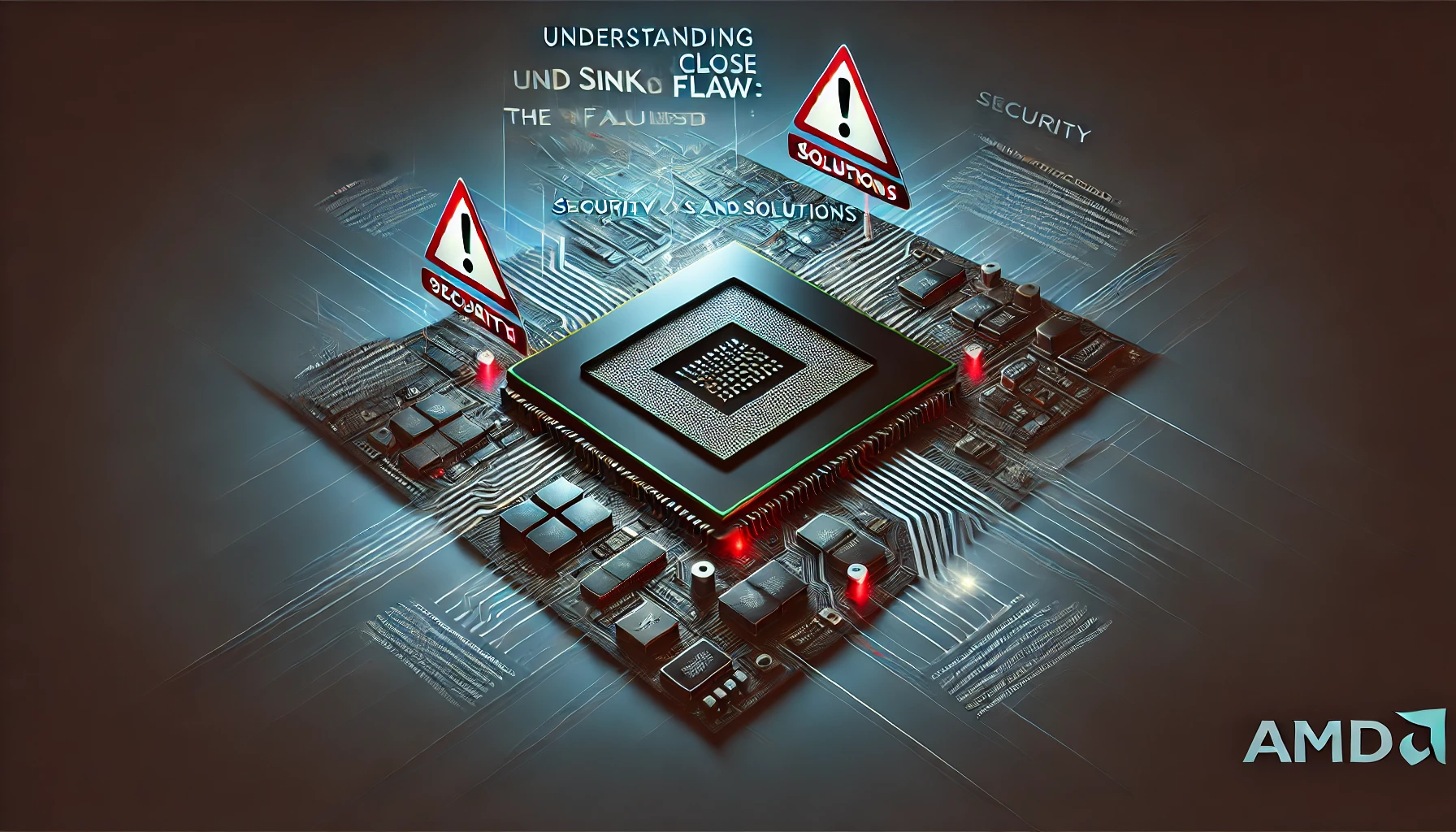The New AMD SinkClose Flaw: Security Risks, Vulnerabilities, and the Path Forward
The New AMD SinkClose Flaw: In the ever-evolving landscape of cybersecurity, staying ahead of vulnerabilities is critical, especially when it comes to hardware-level threats. Recently, AMD has been thrust into the spotlight due to the discovery of a new security flaw known as the SinkClose vulnerability. This flaw, affecting AMD processors, has raised significant concerns about AMD security flaws, with many questioning the potential impact on both individual users and enterprises. In this blog, we will explore the AMD SinkClose flaw, its implications, the company’s response, and the best practices for safeguarding against such vulnerabilities.
AMD Security Issues: A Growing Concern
The tech industry is no stranger to security vulnerabilities, especially those found in hardware components like processors. However, the discovery of new AMD security flaws has amplified concerns among users and cybersecurity professionals alike.
1. The Impact of AMD Security Flaws
AMD processor security issues are not entirely new, but the severity and frequency of these vulnerabilities have been increasing in recent years. The AMD flaw 2024 has drawn particular attention due to its potential to compromise the integrity of systems worldwide.
- Rising Vulnerabilities: The AMD processor vulnerabilities have been a point of concern for some time now. With the rise of sophisticated cyber-attacks, these flaws can be exploited by malicious actors to gain unauthorized access to sensitive information. This makes it crucial for users and organizations to stay vigilant and proactive in addressing these security risks.
- AMD Cybersecurity News: The discovery of the SinkClose vulnerability has dominated AMD cybersecurity news in recent weeks. This flaw highlights the growing challenges faced by hardware manufacturers in securing their products against increasingly complex threats.
2. What Makes AMD Processors Vulnerable?
The AMD security flaw known as SinkClose is a testament to the complex nature of modern processors. These chips, which power everything from personal computers to data centers, are designed to perform billions of operations per second. However, this complexity also introduces potential security gaps that can be exploited.
- Complex Architecture: The intricate architecture of AMD processors makes them powerful, but it also increases the surface area for potential vulnerabilities. The SinkClose vulnerability is a prime example of how specific design choices can inadvertently introduce security risks.
- Exploitation Risks: Once identified, flaws like SinkClose can be exploited through targeted attacks, leading to severe consequences. This underscores the importance of addressing AMD security updates promptly to mitigate the risk of exploitation.
In-Depth Look at the SinkClose Vulnerability
The SinkClose vulnerability has been identified as a significant threat to AMD processors, raising alarms across the cybersecurity community. But what exactly is this flaw, and how does it impact the security of affected systems?
1. What is the SinkClose Vulnerability?
The SinkClose vulnerability is a flaw in the way certain AMD processors handle specific operations. This flaw can potentially allow attackers to bypass security protocols, gaining unauthorized access to system resources and sensitive data.
- Technical Overview: At its core, the SinkClose AMD flaw involves a vulnerability in the processor’s microarchitecture. This flaw could be exploited by sophisticated attackers to execute unauthorized code or access protected memory regions, leading to data breaches or system compromises.
- Affected Systems: The SinkClose vulnerability affects a wide range of AMD processors, from those used in consumer devices to high-performance servers. This broad impact makes it a critical issue that needs immediate attention from both AMD and its users.
2. How Can SinkClose Be Exploited?
The exploitation of the SinkClose AMD flaw requires a high level of technical expertise, but the potential damage is substantial. Attackers can use this flaw to execute malicious code at a low level, potentially bypassing even advanced security measures.
- Attack Vectors: The most likely method of exploitation involves sophisticated malware designed to target the specific flaw within AMD processors. Once exploited, this vulnerability can allow attackers to gain control over critical system functions, leading to widespread damage.
- Real-World Examples: While there have been no widespread reports of the SinkClose exploit being used in the wild, the potential for such attacks remains a significant concern. As with any newly discovered vulnerability, the window of opportunity for attackers is narrow but critical.
AMD’s Response and Security Updates
In response to the discovery of the SinkClose vulnerability, AMD has taken several steps to address the issue and protect its users. The company’s efforts to release AMD security updates demonstrate its commitment to mitigating the risks associated with this flaw.
1. AMD’s Official Response
Upon discovering the SinkClose vulnerability, AMD acted swiftly to assess the scope of the issue and develop a comprehensive plan to address it.
- Security Patches: AMD has released a series of AMD security updates designed to patch the SinkClose vulnerability across its affected processors. These updates are essential for preventing the exploitation of this flaw and protecting systems from potential attacks.
- Public Communication: AMD has also made efforts to keep the public informed about the SinkClose vulnerability and the steps being taken to mitigate it. This transparency is crucial for maintaining user trust and ensuring that the necessary updates are applied promptly.
2. The Importance of Timely Updates
One of the most effective ways to protect against the SinkClose vulnerability is to apply AMD security updates as soon as they become available. These updates are designed to patch the flaw and close any potential attack vectors.
- Updating Systems: Users and organizations should prioritize applying the latest AMD bug fixes to ensure that their systems are protected against the SinkClose vulnerability. Failure to do so could leave systems exposed to potential attacks, with potentially devastating consequences.
- Ongoing Monitoring: It is also important for users to stay informed about AMD cybersecurity news and any new updates that may be released in the future. Regular monitoring and prompt action are key to maintaining the security of AMD-powered systems.
Future Implications and Best Practices
The discovery of the SinkClose vulnerability has significant implications for the future of cybersecurity, particularly in relation to hardware security. As we look ahead, it is clear that addressing such vulnerabilities will require a combination of proactive measures and industry-wide collaboration.
1. Long-Term Implications for AMD
The AMD SinkClose flaw is a reminder of the ongoing challenges faced by hardware manufacturers in securing their products. As cyber threats continue to evolve, companies like AMD will need to invest in advanced security measures to protect against new and emerging vulnerabilities.
- Reputation and Trust: The discovery of the SinkClose vulnerability could impact AMD’s reputation, particularly if the flaw is not addressed promptly and effectively. Maintaining user trust will require a continued focus on security and transparency.
- Industry-Wide Impact: The implications of the SinkClose AMD flaw extend beyond AMD itself, highlighting the need for industry-wide standards and best practices for hardware security. Collaboration between manufacturers, security researchers, and policymakers will be essential in addressing these challenges.
2. Best Practices for Protecting Against Vulnerabilities
In light of the SinkClose vulnerability, users and organizations must adopt best practices to protect their systems against potential threats. These practices include:
- Regular Updates: Ensure that all systems are updated with the latest AMD security updates and patches to protect against known vulnerabilities.
- Vulnerability Management: Implement a robust vulnerability management program to identify, assess, and address potential security flaws in a timely manner.
- Security Awareness: Stay informed about the latest AMD cybersecurity news and developments in hardware security to remain vigilant against new threats.
Conclusion: Navigating the Future of Cybersecurity
The AMD SinkClose flaw represents a significant challenge for both AMD and its users, highlighting the critical importance of proactive security measures. As we have seen, the impact of AMD security flaws can be far-reaching, with potential consequences for both individual users and large organizations.
In conclusion, addressing the SinkClose vulnerability requires a combination of prompt action, ongoing vigilance, and industry-wide collaboration. By staying informed and taking the necessary steps to protect against this flaw, users can help safeguard their systems and contribute to a more secure digital landscape.
For more information on cybersecurity and best practices, visit Regent Studies, where you can find valuable resources and insights. Additionally, for the latest updates on AMD and other tech news, consider following reputable sources like TechCrunch.
As we navigate the future of cybersecurity, the lessons learned from the AMD SinkClose flaw will undoubtedly shape the strategies and technologies that protect us in the years to come.




